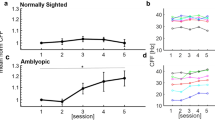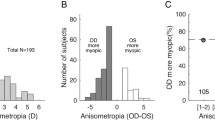Abstract
The most frequent cause of visual loss in childhood is functional amblyopia, an abnormality of visual acuity usually associated with either anisometropia (unequal refractive errors) or strabismus (turned eye) during early development. The usual clinical investigation of the visual acuity of amblyopes involves discrimination of the high contrast letters of a Snellen chart; however, there are other aspects of acuity, for example, grating acuity (the high spatial frequency limit of vision) and Vernier acuity (the smallest perceptible misalignment). Because of the extreme precision of Vernier acuity compared with either grating or Snellen acuity, it is considered to be a form of hyperacuity which requires very precise positional information. In an effort to understand the nature of the neural abnormalities which cause the reduced acuity of amblyopes, we have measured here the Vernier acuity of amblyopic observers using an extended Vernier grating stimulus, and compared these results with their Snellen acuity and grating acuity. The results showed that different acuity losses are associated with anisometropic versus strabismic amblyopia. When scaled with respect to their grating acuity, anisometropic amblyopes, like normals, showed hyperacuity, even at high spatial frequencies, while strabismic amblyopes showed severe losses in Vernier acuity. Snellen letter acuity showed a similar deficit relative to grating acuity in strabismic but not in anisometropic amblyopes. Contrary to some previous theories which have considered that all forms of amblyopia share a comon neural basis, these results strongly support the view1,2 that different neural losses are associated with amblyopias of different aetiologies.
This is a preview of subscription content, access via your institution
Access options
Subscribe to this journal
Receive 51 print issues and online access
$199.00 per year
only $3.90 per issue
Buy this article
- Purchase on Springer Link
- Instant access to full article PDF
Prices may be subject to local taxes which are calculated during checkout
Similar content being viewed by others
References
Hess, R. & Bradley, A. Nature 287, 463–464 (1980).
Hess, R., Campbell, F. & Zimmern, R. Vision Res. 20, 295–306 (1980).
Dorfman, D. & Alf, A. J. math. Psychol. 6, 487–496 (1969).
Davidson, D. & Eskridge, B. Am. J. Optom. Physiol. Optics 54, 756–766 (1977).
Berkeley, M. & Sprague, J. in Frontiers in Visual Science (eds Cool, S. & Smith, E.) 220–239 (Springer, New York, 1978).
Flom, M., Weymouth, F. & Kahneman, D. J. opt. Soc. Am. 53, 1026–1032 (1963).
Pugh, M. Br. J. Ophthal. 42, 449–460 (1958).
Hess, R., Campbell, F. & Greenhalgh, T. Pflügers Arch. ges. Physiol. 377, 201–207 (1978).
Bedell, H. & Flom, M. Invest. Ophthal. vis. Sci. 20, 263–268 (1981).
Author information
Authors and Affiliations
Rights and permissions
About this article
Cite this article
Levi, D., Klein, S. Hyperacuity and amblyopia. Nature 298, 268–270 (1982). https://doi.org/10.1038/298268a0
Received:
Accepted:
Issue Date:
DOI: https://doi.org/10.1038/298268a0
This article is cited by
-
Extended perceptive field revealed in humans with binocular fusion disorders
Scientific Reports (2023)
-
Abnormal basic visual processing functions in binocular fusion disorders
Scientific Reports (2023)
-
Repetitive visual cortex transcranial random noise stimulation in adults with amblyopia
Scientific Reports (2021)
-
Effect of amblyopia treatment on macular microvasculature in children with anisometropic amblyopia using optical coherence tomographic angiography
Scientific Reports (2021)
-
Neural sources of letter and Vernier acuity
Scientific Reports (2020)
Comments
By submitting a comment you agree to abide by our Terms and Community Guidelines. If you find something abusive or that does not comply with our terms or guidelines please flag it as inappropriate.



